Edward ROWELL Randie Rowell Plaintiffs v POWERSCREEN INTERNA
Edward ROWELL; Randie Rowell, Plaintiffs,
v.
POWERSCREEN INTERNATIONAL, LIMITED, a United Kingdom Corporation;
Powerscreen of Arizona, Inc., an Arizona Corporation, Defendants.
POWERSCREEN INTERNATIONAL, LIMITED, a United Kingdom Corporation;
Powerscreen of Arizona, Inc., an Arizona Corporation, Third-Party Plaintiffs,
v.
CLING-SURFACE COMPANY, Third-Party Defendant.
No. CV-S-91-310-PMP (RJJ).
United States District Court, D. Nevada.
July 20, 1992.
1460*1460 Richard C. Sipan, Lyles, Austin & Burnett, Ltd., Las Vegas, NV, for
plaintiffs.
Leland Eugene Backus, Ginger R. James, Thorndal, Backus, Maupin & Armstrong, Las
Vegas, NV, for defendants.
Mark Ferrario, Keefer, O\'Reilly & Ferrario, Las Vegas, NV, for third-party defendants.
ORDER
PRO, District Judge.
Before the Court is Defendants Powerscreen International Limited (\"PSI\") and
Powerscreen of Arizona, Incorporated\'s (\"POA\") Motion for Summary Judgement (#
77) which was filed on May 29, 1992. Plaintiffs Edward Rowell and Randie Rowell
(\"Rowell\") filed their Opposition (# 93) on June 17, 1992. Defendants filed their
Reply (# 97) on July 1, 1992.
I. Facts
On July 26, 1988, POA sold a powerscreen produced by PSI to KMI Materials, Inc.
(\"KMI\"), a sand and gravel pit operated in Las Vegas, Nevada. During the relevant
time in question, Plaintiff Edward Rowell was employed with KMI as a foreman at
the KMI pit. Included within Rowell\'s duties as foreman was the operation and
maintenance of the powerscreen. A \"powerscreen\" is a machine which uses a system
of conveyer belts to carry minerals into a mechanism which then crushes and sorts
them by size.
On October 31, 1988, Rowell installed a new belt on the powerscreen. The next day,
November 1, 1988, Rowell noticed that when material was placed on the new belt,
the belt slipped. To remedy this, Rowell attempted several times to adjust the
tension on the belt to reduce the slipping. 1461*1461 After this failed, Rowell went
to his truck and retrieved a solid bar belt dressing, or \"tar stick.\"[1] After returning
from his truck, Rowell slowed the powerscreen down to its idle speed and
attempted to apply the tar stick onto the powerscreen\'s moving belt. However,
instead of the tar coming off the stick onto the belt as intended, the tar stick adhered
to the belt. This resulted in Rowell\'s hand being pulled into the space between the
belt and pulley, and ultimately, the loss of Rowell\'s left arm.
2
Other facts significant to the instant motion include the following: (1) although the
powerscreen manuals and brochures do not mention the use of belt dressings, they
do advise that in order to solve problems involving belt slippage, the belts should be
properly adjusted and lagged;[2] (2) the powerscreen manual warns the operator
never to carry out maintenance or make any adjustments while the powerscreen is
in operation;[3] (3) although Rowell did not read the label on the tar stick, it also
contained a warning that the tar stick should never be used while a belt is in
operation;[4] (4) although the powerscreen was designed to have warning labels on
the machine, Rowell stated that he never saw such a warning on the powerscreen
that injured him;[5] (5) prior to the accident, Rowell had exclusively used spray or
aerosol dressings in the maintenance of the powerscreen; and (6) in the late 1980\'s,
tar sticks became obsolete in their use as a belt dressing.[6]
The expert testimony in this case in conflicting as it relates to the cause of Rowell\'s
accident. Plaintiff\'s expert, James K. Blundell, states that had there been a nip point
guard in the area where Rowell\'s hand was drawn into the powerscreen, the
accident would not have happened. See Opposition (# 93), Exhibit 2, p. 4. In
contrast, Defendant\'s expert, Howard Elwell, states that the accident in this case
would not have occurred if Rowell would have done any of the following: (1) used
an aerosol dressing instead of the tar stick; (2) turned off the powerscreen before
applying the tar stick; (3) applied the tar stick at a point further from the roller; or
(4) applied the tar stick to the outfeed side of the roller as opposed to the infeed
side. See Motion for Summary Judgement (# 77), Affidavit of Howard Elwell, p. 8.
II. Standard of Review
Pursuant to Federal Rule of Civil Procedure 56, summary judgment is proper \"if the
pleadings, depositions, answers to interrogatories, and admissions on file, together
with the affidavits, if any, show that there is no genuine issue as to any material fact
and that the moving party is entitled to a judgment as a matter of law.\"
The party moving for summary judgment has the initial burden of showing the
absence of a genuine issue of material fact. See Adickes v. S.H. Kress & Co., 398 U.S.
144, 90 S.Ct. 1598, 26 L.Ed.2d 142 1462*1462 (1970); Zoslaw v. MCA Distrib.
Corp., 693 F.2d 870, 883 (9th Cir.1982). Once the movant\'s burden is met by
presenting evidence which, if uncontroverted, would entitle the movant to a
directed verdict at trial, the burden then shifts to the respondent to set forth specific
facts demonstrating that there is a genuine issue for trial. Anderson v. Liberty Lobby,
Inc., 477 U.S. 242, 250, 106 S.Ct. 2505, 2511, 91 L.Ed.2d 202 (1986). If the factual
context makes the respondent\'s claim implausible, that party must come forward
with more persuasive evidence than would otherwise be necessary to show that
there is a genuine issue for trial. Celotex Corp. v. Catrett, 477 U.S. 317, 323-24, 106
S.Ct. 2548, 2552-53, 91 L.Ed.2d 265 (1986); Matsushita Elec. Indus. Co. v. Zenith
Radio Corp., 475 U.S. 574, 586-87, 106 S.Ct. 1348, 1356-57, 89 L.Ed.2d 538
(1986); California Arch. Bldg. Prod. v. Franciscan Ceramics, 818 F.2d 1466, 1468 (9th
Cir.1987), cert. denied, 484 U.S. 1006, 108 S.Ct. 698, 699, 98 L.Ed.2d 650 (1988).
3
If the party seeking summary judgment meets this burden, then summary judgment
will be granted unless there is significant probative evidence tending to support the
opponent\'s legal theory. Long v. Bureau of Economic Analysis, 646 F.2d 1310, 1321
(9th Cir.1981); Commodity Futures Trading Commission v. Savage, 611 F.2d 270 (9th
Cir.1979). Parties seeking to defeat summary judgment cannot stand on their
pleadings once the movant has submitted affidavits or other similar materials.
Affidavits that do not affirmatively demonstrate personal knowledge are
insufficient. Long, 646 F.2d at 1321. Likewise, \"legal memoranda and oral argument
are not evidence and do not create issues of fact capable of defeating an otherwise
valid motion for summary judgment.\" Id., citing British Airways Bd. v. Boeing Co., 585
F.2d 946 (9th Cir. 1978), cert. denied, 440 U.S. 981, 99 S.Ct. 1790, 60 L.Ed.2d 241
(1979).
A material issue of fact is one that affects the outcome of the litigation and requires a
trial to resolve the differing versions of the truth. See Admiralty Fund v. Hugh
Johnson & Co., 677 F.2d 1301, 1305-06 (9th Cir.1982); Admiralty Fund v. Jones,677
F.2d 1289, 1293 (9th Cir.1982).
All facts and inferences drawn must be viewed in the light most favorable to the
responding party when determining whether a genuine issue of material fact exists
for summary judgment purposes. Poller v. CBS, Inc., 368 U.S. 464, 82 S.Ct. 486, 7
L.Ed.2d 458 (1962). After drawing inferences favorable to the respondent, summary
judgment will be granted only if all reasonable inferences defeat the respondent\'s
claims. Admiralty Fund v. Tabor, 677 F.2d 1297, 1298 (9th Cir.1982).
The trilogy of Supreme Court cases cited above establishes that \"[s]ummary
judgment procedure is properly regarded not as a disfavored procedural shortcut,
but rather as an integral part of the Federal Rules as a whole, which are designed `to
secure the just, speedy and inexpensive determination of every action.\'\" Celotex
Corp., 477 U.S. at 327, 106 S.Ct. at 2555, quoting Fed.R.Civ.P.1. See also Avia Group
Int\'l, Inc. v. L.A. Gear Cal., 853 F.2d 1557, 1560 (Fed.Cir.1988).
III. Discussion
Under Nevada law, in order to successfully bring a strict products liability claim, a
plaintiff must show that: 1) the product had a defect which rendered it
unreasonably dangerous, 2) the defect existed at the time the product left the
manufacturer, and 3) the defect caused the plaintiff\'s injury. Fyssakis v. Knight
Equipment Corp., 108 Nev. 212, 826 P.2d 570, 571 (1992). The lack of adequate
safety features or the feasibility of a safer alternative design in a product may
constitute an unreasonably dangerous defect. Robinson v. G.G.C., Inc., 107 Nev. 135,
808 P.2d 522, 524-525 (Nev.1991). In addition, a product may be defective if it does
not adequately communicate the dangers which may result from its use or
foreseeable misuse. Fyssakis, 826 P.2d, at 572; Oak Grove Investors v. Bell & Gossett,
Co., 99 Nev. 616, 668 P.2d 1075, 1080 (Nev.1983). Nonetheless, a manufacturer may
not be held liable for injury resulting from a product\'s 1463*1463abnormal or
unintended use or from a plaintiff\'s assumption of the risk. Central Telephone Co. v.
4
Fixtures, Mfg., 103 Nev. 298, 300, 738 P.2d 510 (Nev.1987); Crown Controls Corp. v.
Corella, 98 Nev. 35, 639 P.2d 555, 557 (Nev.1982); General Electric Co. v. Bush, 88
Nev. 360, 498 P.2d 366, 369 (Nev.1972).
In support of their motion for summary judgment, Defendants make several
arguments including: (1) that Rowell\'s use of the tar stick was an unforeseeable
misuse of the powerscreen; (2) the powerscreen was not unreasonably dangerous;
and (3) that Rowell\'s use of the tar stick, and not any defect, was the proximate
cause of the accident. Notwithstanding these arguments, given Nevada law,
Defendants motion for summary judgement must be denied.
First of all, with regard to the issue of unforeseeable misuse, the primary facts which
support Defendants\' position are that tar sticks or solid bar belt dressings became
obsolete in the late 1980\'s with the advent of aerosols and that Rowell was negligent
in applying the tar stick. In contrast, several facts support the contention that the
use of a tar stick was foreseeable. For example, even though Defendants\' manuals
did not address the use of belt dressing, it is apparent from the record that
powerscreen belts were prone to slipping and that bar dressings were commonly
used to solve such problems. Even though production of tar sticks ceased three to
four years ago, tar sticks were still available in the market place shortly before the
date of the accident. In addition to these facts, Plaintiff\'s expert, Blundell, offered a
statement to the effect that use of a belt dressing while machinery was in operation
was foreseeable. See Opposition (# 93), Exhibit 2. Although a jury might well find for
Defendants on this issue, construing all factual inferences in favor of the Plaintiff, it
cannot be said that a material question of fact does not still exist with regard to the
whether Rowell\'s use of the powerscreen was a unforeseeable misuse.
Citing basically the same facts used in their first argument, Defendants\' second basis
for summary judgement is that the powerscreen worked as intended and was not
unreasonably dangerous as a matter of law. In conflict with this position however, is
Rowell\'s evidence that the machine in question did not contain the warning decal
designed to be on the powerscreen and that the placement of a nip point guard
could have prevented the accident. See Opposition (# 93), Exhibit 2. Again, given
that this evidence if construed in favor of Rowell could support a jury finding that
the powerscreen was defective, Defendants\' motion for summary judgement on this
issue must also be denied.
Finally, this Court must also reject Defendants\' contention that the proximate cause
of Rowell\'s accident was his own \"negligent\" use of the tar stick. Under Nevada law,
this Court is bound to look at the proximate cause of Rowell\'s injuries, and not the
proximate cause of the accident. See Andrews v. Harley Davidson, Inc., 106 Nev. 533,
796 P.2d 1092, 1095 (Nev.1990). In the present case, it is undisputed that the
powerscreen was the proximate cause of Rowell\'s injuries. The fact that Rowell\'s
allegedly negligent application of the tar stick would be relevant to the issue of
unforeseeable misuse is irrelevant to the issue of causation. Accordingly,
5
Defendants\' third argument in support of summary judgement must also be
rejected.
ORDER
IT IS THEREFORE ORDERED that Defendants\' Motion for Summary Judgement (#
77) is hereby denied.
NOTES
[1] A \"tar stick\" is a cylindrical stick approximately 10 inches in length with a hard
tar-like substance on its end which is spread on a belt to prevent slippage.
[2] See Motion for Summary Judgement (# 77), Affidavit of Howard Elwell, p. 8.
[3] See Motion for Summary Judgement (# 77), Statement of Facts Not Genuinely in
Issue, p. 7.
[4] More specifically, the warning on the tar stick stated:
All belts must be stopped when applying belt dressing. Do not apply to moving belt
for you may suffer serious bodily injury by being caught in moving machinery.
See Opposition (# 93), Exhibit 1, p. 6.
[5] See Motion for Summary Judgment (# 77), Rowell Deposition, p. 66.
[6] As noted in the deposition of Mr. Henry Wilson (\"Wilson\"), President of Cling
Surface Company (\"Cling Surface\") and the company which manufactured the tar
stick used by Rowell, the use of tar sticks as belt dressings in the United States
essentially ceased in the late 1980\'s. Wilson also testified that Cling Surface stopped
producing tar sticks in late 1988 or 1989, its last sale of tar sticks occurred in 1989,
and that to the best of his knowledge, no other manufacturers of solid bar belt
dressings were still selling such a product. Reasons given for the demise of tar sticks
include the fact that more convenient and allegedly safer aerosol belt dressings
were introduced as well as the fact that leather belts, for which the tar sticks were
originally designed, had been replaced by rubber belts. See Opposition (# 93),
Exhibit 1, p. 4-6; Reply (# 97), Exhibit A; see also Motion for Summary Judgement (#
77), Affidavit of Howard Elwell.
Need help to IRAC this case.
The basic structure is: Issue, Rule, Analysis, and Conclusion. .
Solution
IRAC (Issue, Rule, Analysis, and Conclusion):
Issue:
The issue was that Plaintiff Edward Rowell who was employed as a foreman in the KMI Materials, Inc. was lost his left arm during his job on 1 Nov, 1988. His job was duty was the operation and maintenance of the power screen.
Rule:
The law of Nevada states that liability claim of the products would be done by the plaintiff if: 1) the product had a defect which rendered it unreasonably dangerous, 2) the defect existed at the time the product left the manufacturer, and 3) the defect caused the plaintiff\'s injury.
Analysis:
The analysis is done on the basis of the final note that the product tar sticks was banned in usage in 1980’s in the United States which was used by the Rowell for belt dressings. The reason was that the more convenient and allegedly safer aerosol belt dressings were introduced. Leather belts was replaced by rubber belts.
The procedure whish was followed by the Rowell was same as before and he was not guided by any kind of safety note by the company.
Conclusion:
The decision was in favour of the plaintiff Edward Rowell who was the sufferer from this incident. He has lost his left arm because of the banned material used by the company.
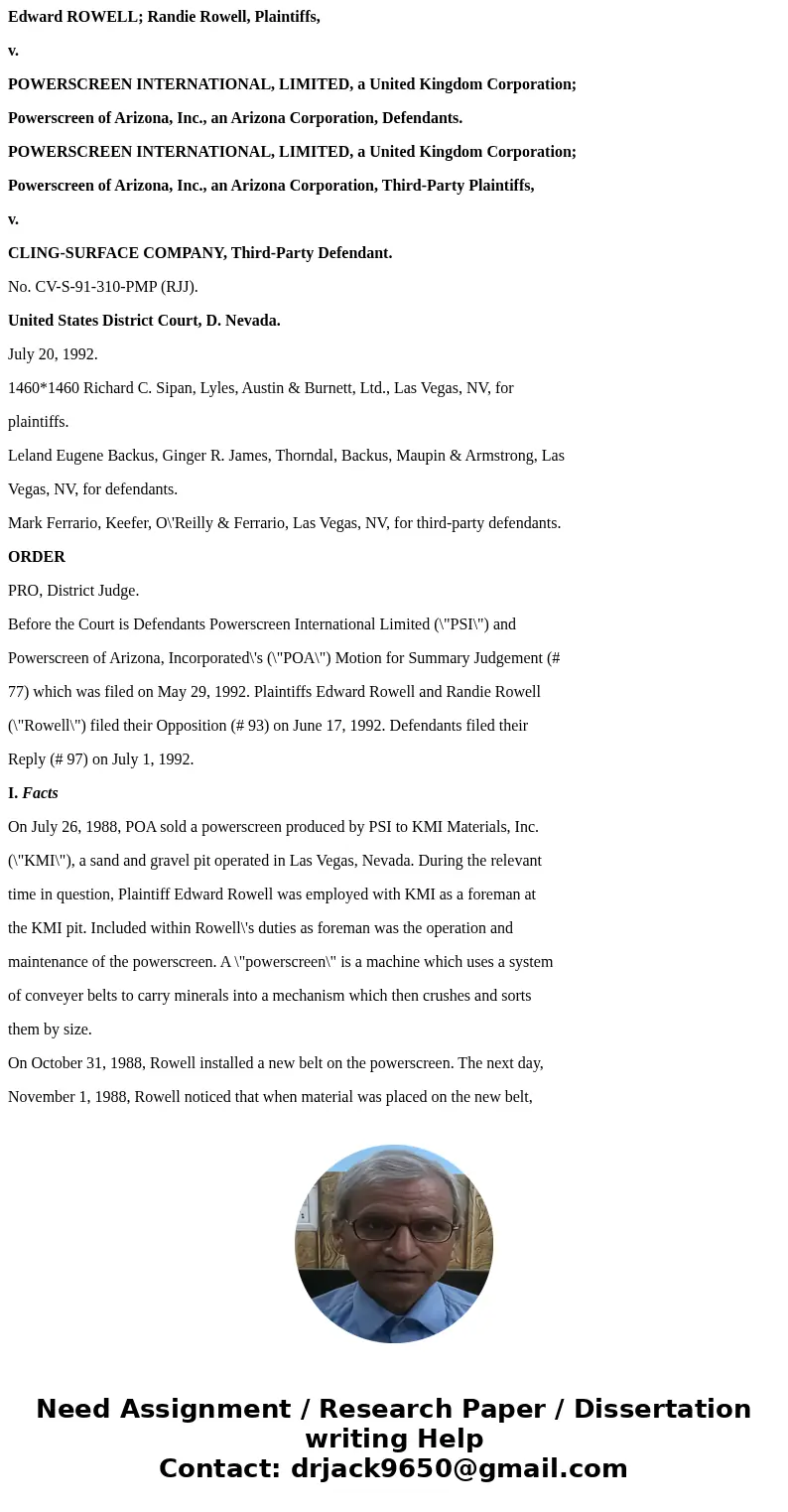
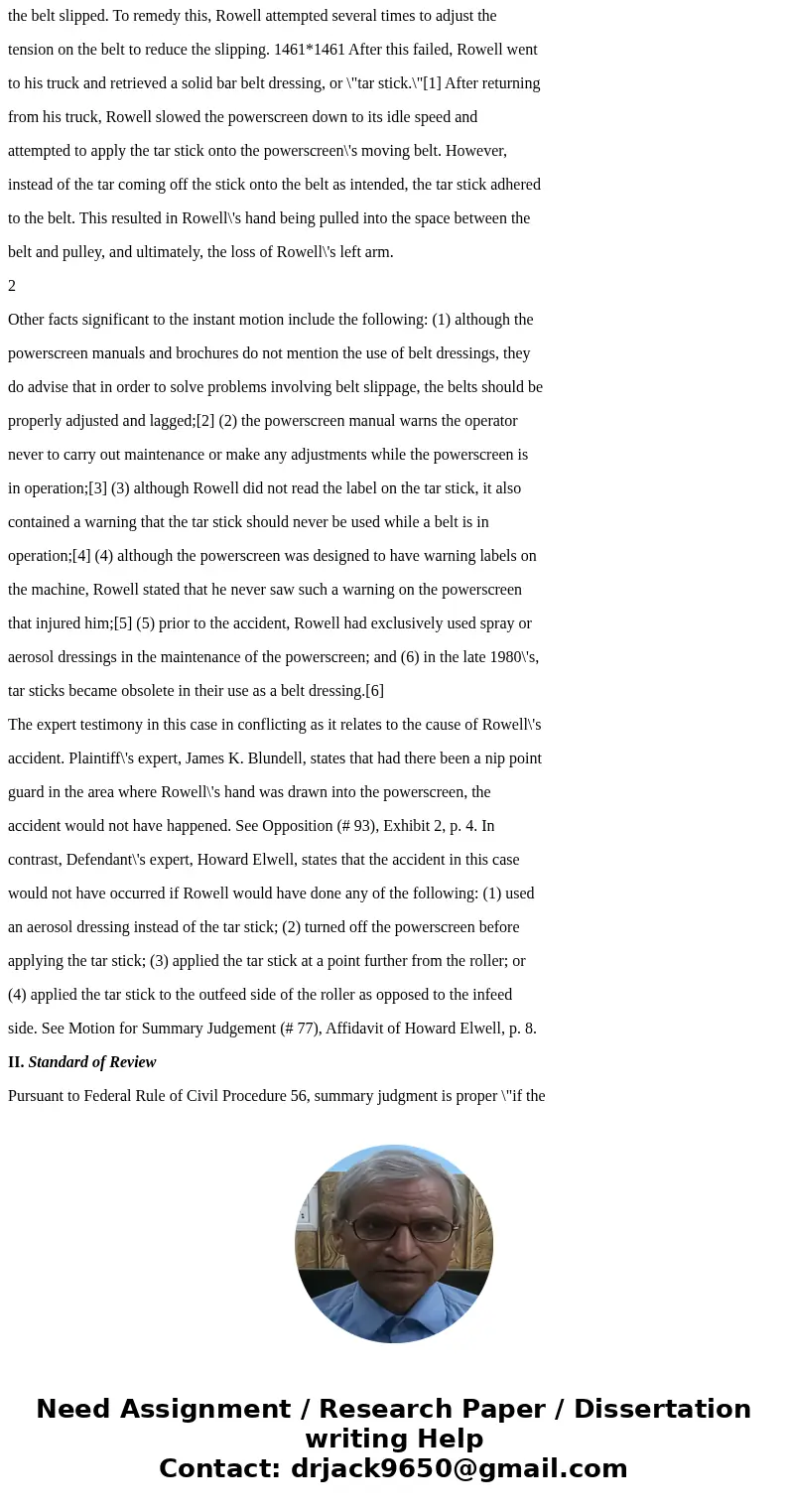
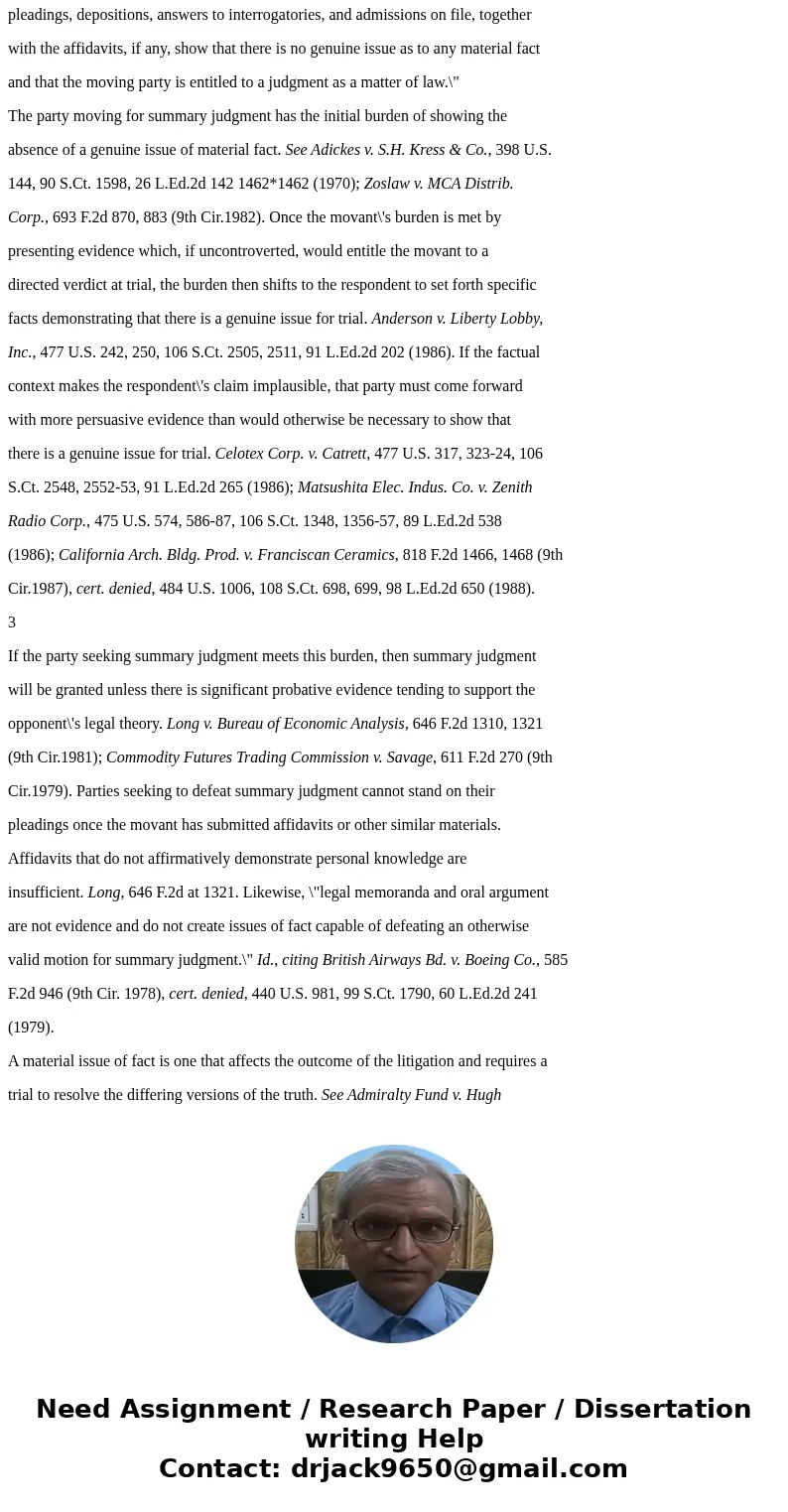
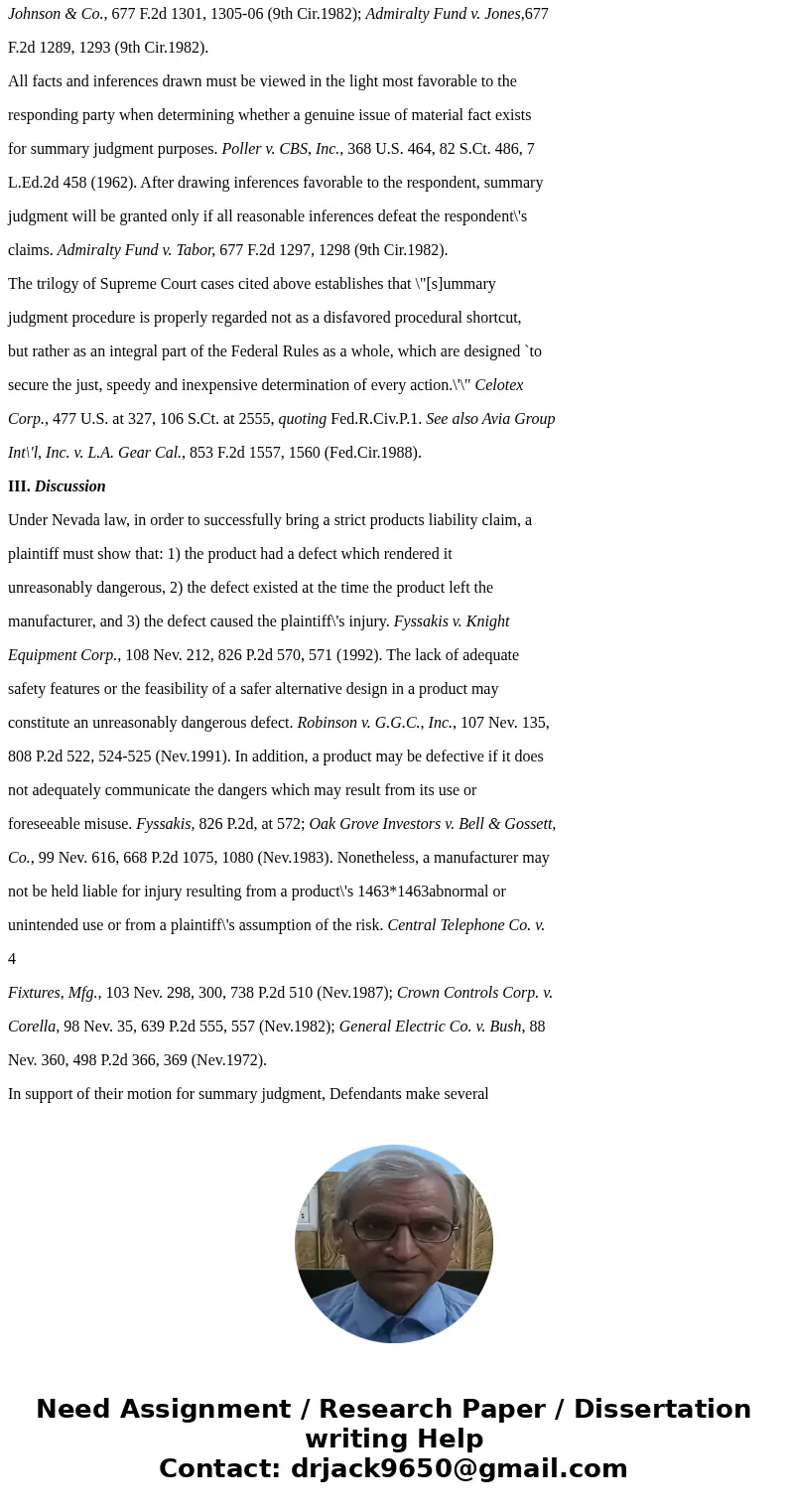
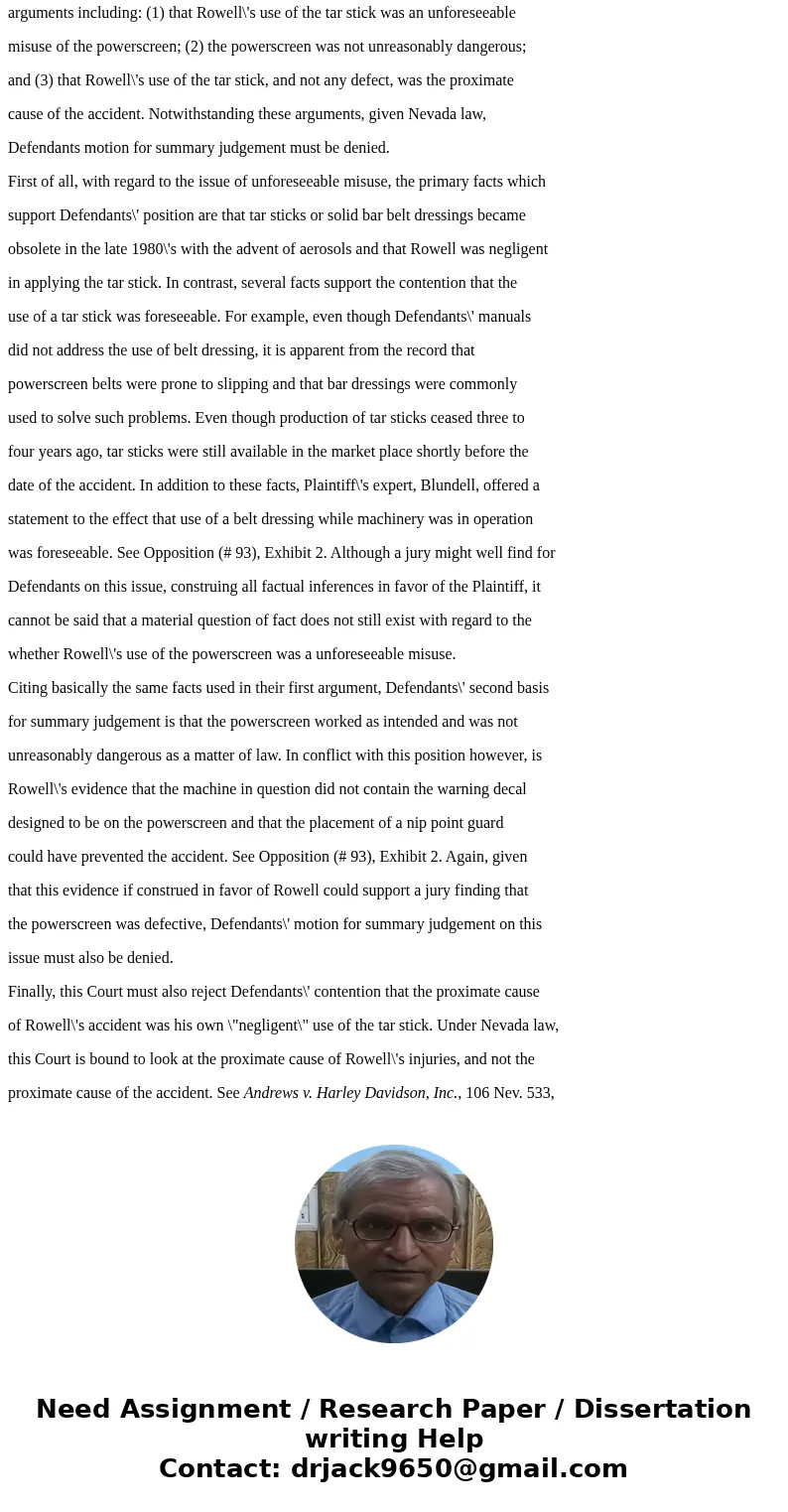
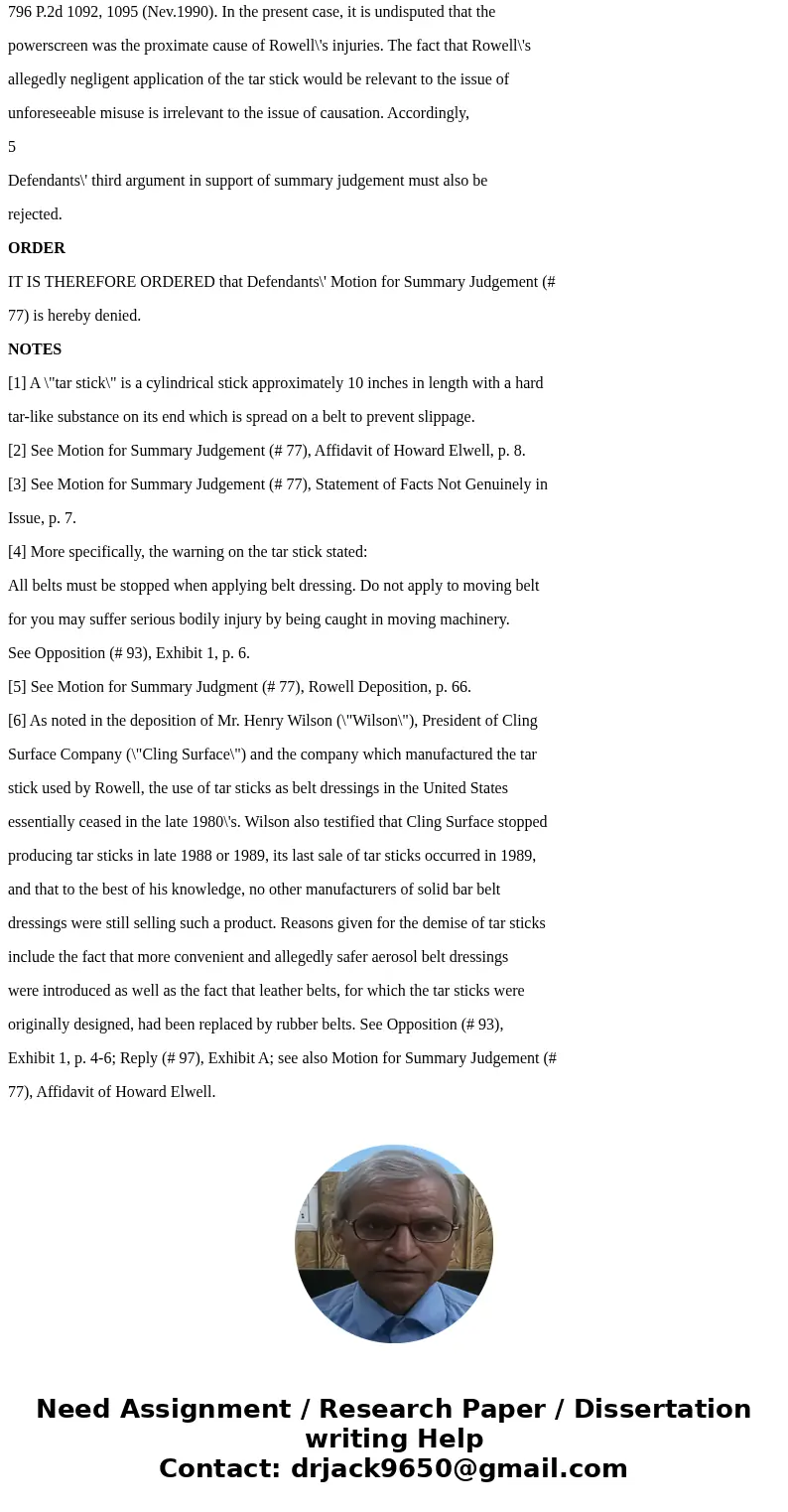
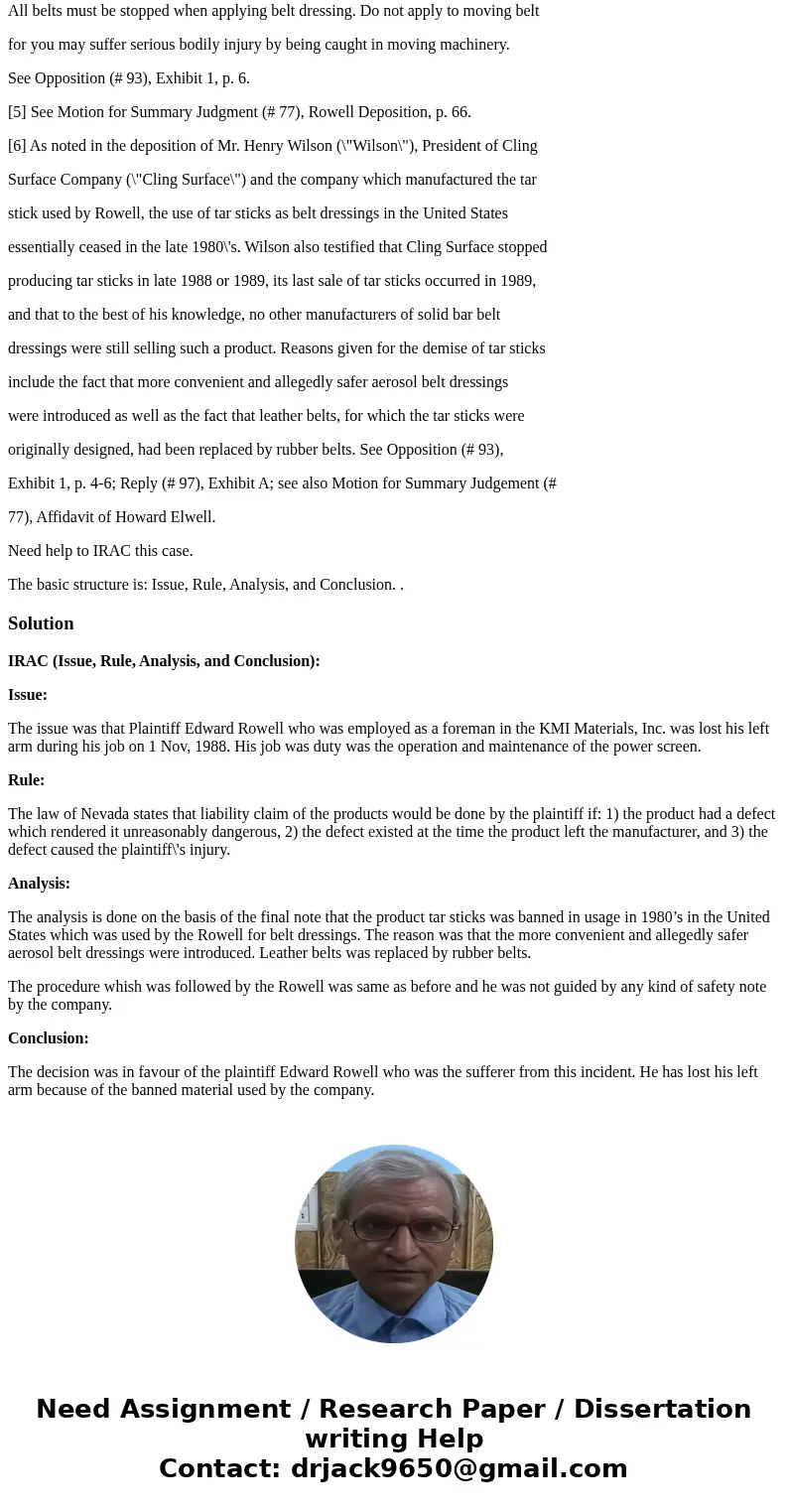
 Homework Sourse
Homework Sourse